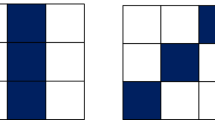Abstract
The proposed method is related to parametric and geodesic active contours as well as minimal paths, in the context of image segmentation. Our geodesically linked active contour model consists in a set of vertices connected by paths of minimal cost. This makes up a closed piecewise defined curve, over which an edge or region energy functional is formulated. The greedy algorithm is used to move vertices towards a configuration minimizing the energy functional. This evolution technique ensures lower sensitivity to erroneous local minima than usual gradient descent of the energy. Our method intends to take advantage of explicit active contours, minimal paths and greedy evolution techniques.
Preview
Unable to display preview. Download preview PDF.
Similar content being viewed by others
References
Kass, M., Witkin, A., Terzopoulos, D.: Snakes: active contour models. International Journal of Computer Vision 1(4), 321–331 (1988)
Osher, S., Sethian, J.: Fronts propagation with curvature-dependent speed: algorithms based on Hamilton-Jacobi formulations. Journal of Computational Physics 79, 12–49 (1988)
Malladi, R., Sethian, J., Vemuri, B.: Shape modeling with front propagation: a level set approach. IEEE Transactions on Pattern Analysis and Machine Intelligence 17(2), 158–175 (1995)
Caselles, V., Kimmel, R., Sapiro, G.: Geodesic active contours. International Journal of Computer Vision 22(1), 61–79 (1997)
Cohen, L.: On active contour models and balloons. Computer Vision, Graphics, and Image Processing: Image Understanding 53(2), 211–218 (1991)
Amini, A., Weymouth, T., Rain, R.: Using dynamic programming for solving variational problems in vision. IEEE Transactions on Pattern Analysis and Machine Intelligence 12(9), 855–867 (1990)
Geiger, D., Gupta, A., Luiz, A., Vlontzos, J.: Dynamic programming for detecting, tracking, and matching deformable contours. IEEE Transactions on Pattern Analysis and Machine Intelligence 17(3), 294–302 (1995)
Williams, D., Shah, M.: A fast algorithm for active contours and curvature estimation. Computer Vision, Graphics, and Image Processing: Image Understanding 55(1), 14–26 (1992)
Sakalli, M., Lam, K.M., Yan, H.: A faster converging snake algorithm to locate object boundaries. IEEE Transactions on Image Processing 15(5), 1182–1191 (2006)
Cohen, L., Kimmel, R.: Global minimum for active contour models: a minimal path approach. International Journal of Computer Vision 24(1), 57–78 (1997)
Sethian, J.: A fast marching level set method for monotonically advancing fronts. Proceedings of the National Academy of Science 93(4), 1591–1595 (1996)
Chan, T., Vese, L.: Active contours without edges. IEEE Transactions on Image Processing 10(2), 266–277 (2001)
Piovano, J., Rousson, M., Papadopoulo, T.: Efficient segmentation of piecewise smooth images. In: Sgallari, F., Murli, A., Paragios, N. (eds.) SSVM 2007. LNCS, vol. 4485, pp. 709–720. Springer, Heidelberg (2007)
Lankton, S., Tannenbaum, A.: Localizing region-based active contours. IEEE Transactions on Image Processing 17(11), 2029–2039 (2008)
Mille, J., Boné, R., Cohen, L.: Region-based 2D deformable generalized cylinder for narrow structures segmentation. In: Forsyth, D., Torr, P., Zisserman, A. (eds.) ECCV 2008, Part II. LNCS, vol. 5303, pp. 392–404. Springer, Heidelberg (2008)
Farouki, R., Neff, C.: Analytic properties of plane offset curves. Computer Aided Geometric Design 7(1-4), 83–99 (1990)
Author information
Authors and Affiliations
Editor information
Editors and Affiliations
Rights and permissions
Copyright information
© 2009 Springer-Verlag Berlin Heidelberg
About this paper
Cite this paper
Mille, J., Cohen, L.D. (2009). Geodesically Linked Active Contours: Evolution Strategy Based on Minimal Paths. In: Tai, XC., Mørken, K., Lysaker, M., Lie, KA. (eds) Scale Space and Variational Methods in Computer Vision. SSVM 2009. Lecture Notes in Computer Science, vol 5567. Springer, Berlin, Heidelberg. https://doi.org/10.1007/978-3-642-02256-2_14
Download citation
DOI: https://doi.org/10.1007/978-3-642-02256-2_14
Publisher Name: Springer, Berlin, Heidelberg
Print ISBN: 978-3-642-02255-5
Online ISBN: 978-3-642-02256-2
eBook Packages: Computer ScienceComputer Science (R0)




